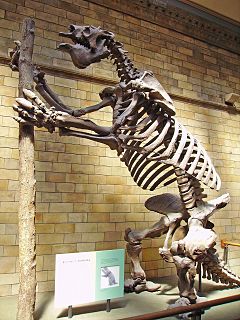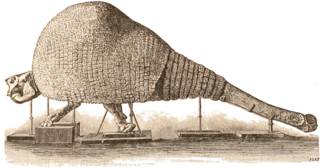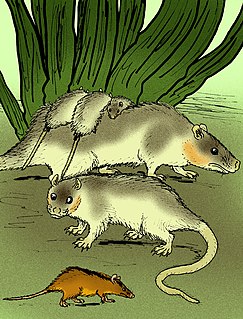
Canidae is a biological family of dog-like carnivorans. A member of this family is called a canid. There are three subfamilies found within the canid family, which are the extinct Borophaginae and Hesperocyoninae, and the extant Caninae. The Caninae are known as canines, and include domestic dogs, wolves, foxes, and other extant and extinct species.

Megatherium is an extinct genus of ground sloths endemic to South America that lived from the Early Pliocene through the end of the Pleistocene. It is best known for the elephant-sized type species M. americanum, sometimes called the giant ground sloth, or the megathere, native to the Pampas through southern Bolivia during the Pleistocene. Various other smaller species belonging to the subgenus Pseudomegatherium are known from the Andes. Megatherium is part of the sloth family Megatheriidae, which also includes the similarly elephantine Eremotherium, which was native to tropical South America and southern North America. Only a few other land mammals equaled or exceeded M. americanum in size, such as large proboscideans and the giant rhinoceros Paraceratherium. Megatherium was first discovered in 1788 on the bank of the Luján River in Argentina. The holotype specimen was then shipped to Spain the following year wherein it caught the attention of the paleontologist Georges Cuvier, who was the first to determine, by means of comparative anatomy, that Megatherium was a sloth. Megatherium became extinct around 12,000 years ago during the Quaternary extinction event, which also claimed most other large mammals in the New World. The extinction coincides with the settlement of the Americas, and a kill site where a M. americanum was slaughtered and butchered is known, suggesting that hunting could have caused its extinction.

The Falkland Islands wolf, also known as the warrah and occasionally as the Falkland Islands dog, Falkland Islands fox, or Antarctic wolf, was the only native land mammal of the Falkland Islands. It became extinct in 1876, the first known canid to have become extinct in historical times.

Dusicyon is an extinct genus of South American canids. The type species is Dusicyon australis, the Falkland Islands wolf. In 1914, Oldfield Thomas established this genus, in which he included the culpeo and other South American foxes. These other canids were removed to Lycalopex by Langguth in 1975. Dusicyon avus, widely distributed in the late Pleistocene from Uruguay through Buenos Aires Province to southernmost Chile, is the closest known relative of the Falkland Islands wolf; the two lineages split only about 16,000 years ago. It died out in the late Holocene, earlier estimates suggested about 2,980 years ago on the island of Tierra del Fuego and almost 1,700 years ago in the continent. More recent research confirms much later extinction dates, with the latest confirmed records in the Pampean Region being 700 BP and southernmost Patagonia at 400 years BP.

The maned wolf is a large canine of South America. Its markings resemble those of foxes, but it is neither a fox nor a wolf. It is the only species in the genus Chrysocyon.

Urocyon is a genus of Canidae which includes the gray fox and the island fox. These two fox species are found in the Western Hemisphere. Whole genome sequencing indicates that Urocyon is the most basal genus of the living canids. Fossils of what is believed to be the ancestor of the gray fox, Urocyon progressus, have been found in Kansas and date to the Upper Pliocene, with some undescribed specimens dating even older.

The South American foxes (Lycalopex), commonly called raposa in Portuguese, or zorro in Spanish, are a genus from South America of the subfamily Caninae. Despite their name, they are not true foxes, but are a unique canid genus related to wolves and jackals; some of them somewhat resemble foxes due to convergent evolution. The South American gray fox, Lycalopex griseus, is the most common species, and is known for its large ears and a highly marketable, russet-fringed pelt.

The Sechuran fox, also called the Peruvian desert fox or the Sechuran zorro, is a small South American species of canid closely related to other South American "false" foxes or zorro. It gets its name for being found in the Sechura Desert in northwestern Peru.

The pampas fox, also known as grey pampean fox, pampas zorro, Azara's fox, or Azara's zorro, is a medium-sized zorro, or "false" fox, native to the South American pampas. Azara in some of its alternative common names is a reference to Spanish naturalist Félix de Azara.

Doedicurus, or Dædicurus, is an extinct genus of glyptodont from South America containing one species, D. clavicaudatus. Glyptodonts are a member of the family Chlamyphoridae, which also includes some modern armadillo species, and they are classified in the order Xenarthra alongside sloths and anteaters. Being a glyptodont, it was a rotund animal with heavy armor and a carapace. Averaging at an approximate 1,400 kg (3,100 lb), it was one of the largest glyptodonts to have ever lived. Though glyptodonts were quadrupeds, large ones like Doedicurus may have been able to stand on two legs like other xenarthrans. It notably sported a spiked tail club, which may have weighed 40 or 65 kg in life, and it may have swung this in defense against predators or in fights with other Doedicurus at speeds of perhaps 11 m/s.

The Caninae, known as canines, are one of three subfamilies found within the canid family. The other two canid subfamilies are the extinct Borophaginae and Hesperocyoninae. The Caninae includes all living canids and their most recent fossil relatives. Their fossils were first found in North America and dated to the Oligocene era, then spreading to Asia at the end of the Miocene era, some 7 million to 8 million years ago.
Protocyon is an extinct genus of small canid endemic to South and North America during the Late Pleistocene living from 0.781 Ma to 12,000 years ago and existed for approximately 0.769 million years .

Theriodictis is an extinct genus of small hypercarnivorous fox-like canid endemic to South America during the Pleistocene, living from 1.2 Ma- 500,000 years ago and existing for approximately 0.7 million years .
Canis nehringi is an extinct species of canid. Canis gezi, a poorly known small wolf from the Ensenadan of South America, appears to have given rise to Canis nehringi, a Lujanian species from Argentina. Betra's analysis in 1988, places Canis dirus and Canis nehringi as sister taxa and as the most derived members of the genus Canis in the New World. The species was first described by Florentino Ameghino in 1902.

Arctotherium is an extinct genus of Pleistocene South American short-faced bears within Ursidae. Their ancestors migrated from North America to South America during the Great American Interchange, following the formation of the Isthmus of Panama during the late Pliocene. The oldest dated confirmed remains are those of A. angustidens from Buenos Aires, Argentina, dating to the Ensenadan epoch, 1.76 to 0.98 Ma old, within the Early to Middle Pleistocene, with a tooth possibly belonging to Arctotherium dating about 2.588 Mya. They are genetically closer to the spectacled bear, than to Arctodus of North America, implying the two extinct forms evolved large size in a convergent manner, perhaps to facilitate dominating other carnivores in the competition for the biggest carcasses. The northernmost species, A. wingei, known from Venezuela in South America, apparently invaded Central America and reached as far north as the Yucatán.

Dusicyon avus is an extinct species of canid in the genus Dusicyon. It was medium to large, about the size of a German shepherd.. It was closely related to the warrah or Falkland Islands wolf, and was the ancestral species from which it diverged. It appears to have survived until very recently, perhaps 400 years ago.

Canini is a taxonomic rank which represents the dog-like tribe of the subfamily Caninae, and is sister to the fox-like tribe Vulpini. The Canini came into existence 9 million years ago. This group was first represented by Eucyon, mostly by Eucyon davisi that was spread widely across North America. Its members are informally known as true dogs.

Thylophorops is an extinct genus of didelphine opossums from the Pliocene of South America. Compared to their close didelphine cousins like the living Philander and Didelphis opossums, Thylophorops displays specialization towards carnivory, and one species, T. lorenzinii, is the largest known opossum of all time, which could imply a macropredatory role.

Cerdocyonina is an extant subtribe of the canines and is exclusively endemic to the Americas. Often described to be "fox-like" in appearance and behavior, they are more closely related to the wolf-like canids such as Canis than they are to the fox genus Vulpes. Its members are colloquially known as the South American canids. They are sometimes referred to as South American foxes in the older literature, but the term zorro has been recommended by mammalogists to avoid confusion with the true foxes of the tribe Vulpini















